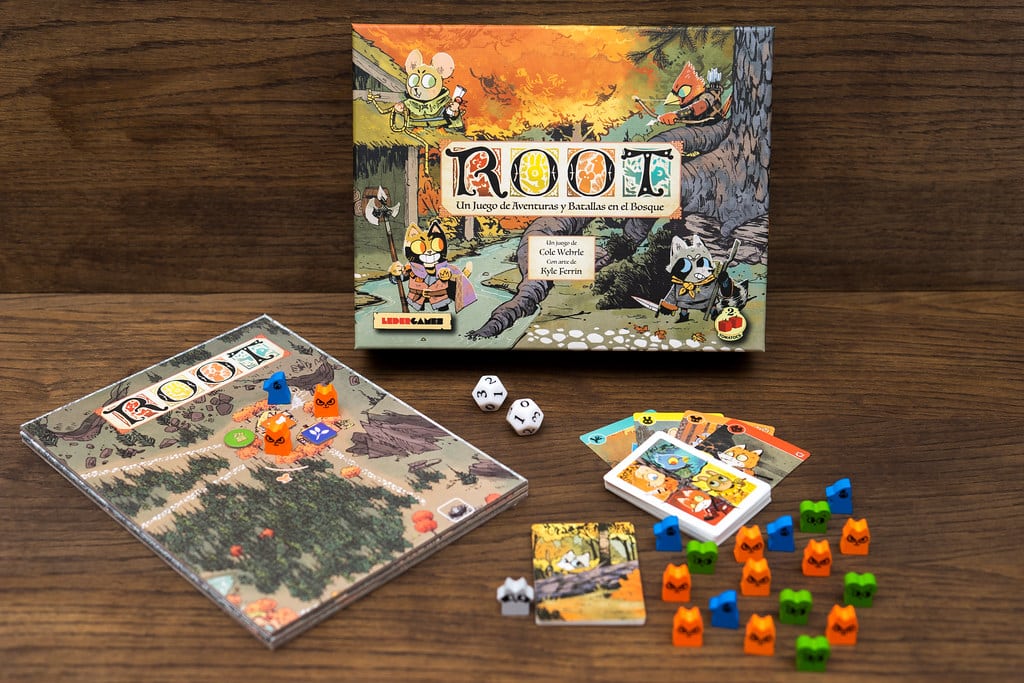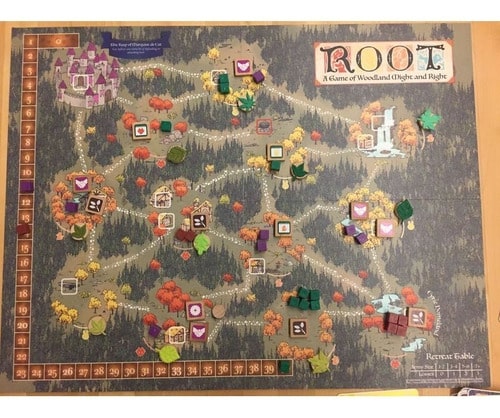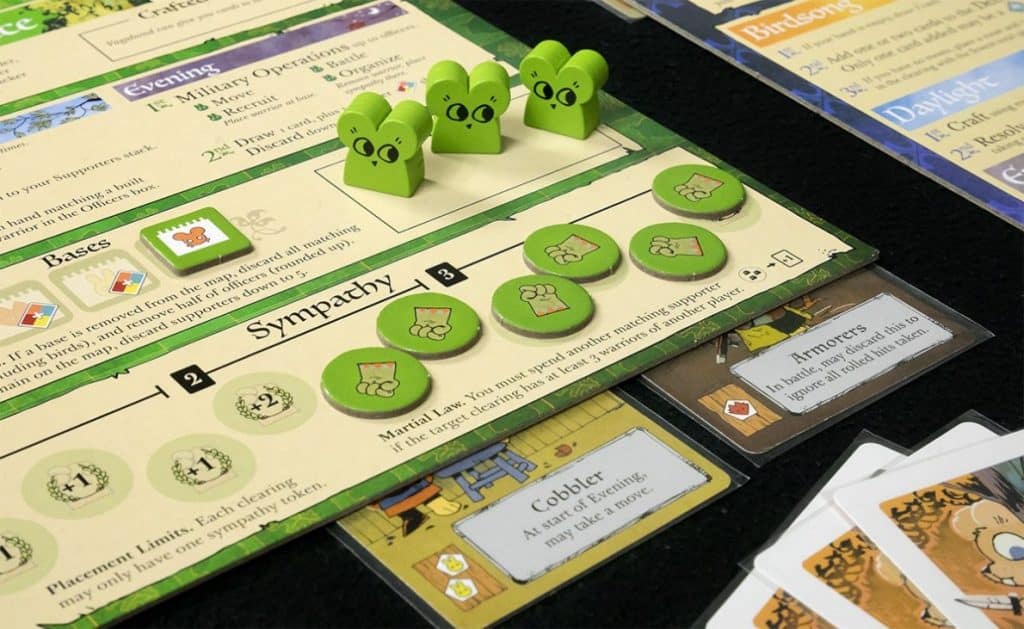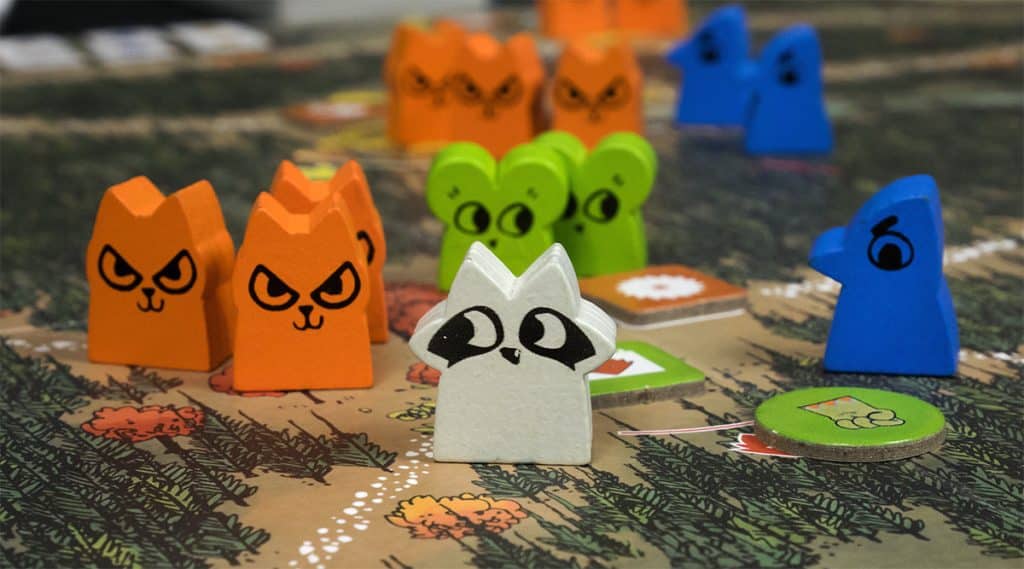
Today we will introduce you to the Root Board Game, a very well designed Eurogame, suitable for 2 to 4 players, in games of 60-90 minutes.
The players must be over 10 years old, because, although Root has a fresh and light look, it has a high level of difficulty.
Don’t let her relaxed look fool you, Root is a game with an adventurous face, but a warrior’s soul.
Root’s gameplay dynamics have a super-achieved logic. The latter speaks very well of him, because nobody likes to buy a board game that later turns out to be dull, or is full of incongruities and forced mechanics. I’m talking about those mechanics that leave gaps, causing you a terrible feeling of meaninglessness and wasted effort.
You know what I mean, don’t you? Well, Root is free of all that.
Root’s reusable. You might say, “There are a lot of replayable board games.” Right, but in that sense Root is unlike anything else, because of a special feature it has, which I’ll tell you about later. (Heh heh, I love the suspense)
I’ll tell you what it’s all about, and how to play it, so that you’ll decide to buy Root’s game with a lot of confidence.
- Root es un juego de aventura y guerra donde 2 a 4 jugadores luchan por el control de un vasto desierto.
- De 2 a 4 jugadores, a partir de 14 años
- 90 - 120 minutos de tiempo de juego
- El escenario está p para un concurso que decidirá el destino del gran bosque. Depende de los jugadores decidir qué grupo se iniciará.
- En Root, los jugadores impulsan la narrativa, y las diferencias entre cada papel crean un nivel inigualable de interacción y rejugabilidad. Leder Games te invita a ti y a tu familia a explorar el fantástico mundo de Root
Root’s Special Board Game Feature
In Root, 4 factions face each other, and each player is going to embody one of them.
There can be unused factions, if there’s not 4 players, there is no problem at all.
Now, each faction has a particular way of achieving victory.
In other words, the central objective of the game can be achieved by all, but each one in a different way, each one has their own game mechanics.
So, because Root is flavoured differently depending on the position it occupies, you can rejuvenate Root by swapping factions, and it’s like a new game.
Cool, huh? If you have any doubts, just wait until you know the mechanics, and you’ll be convinced.
So What’s the Goal in Root?

The game is set in Forest Land, where there are clearings in the forest, and rabbits (yellow clear), foxes (red clear), and mice (orange clear) are living there.
There are also birds (turquoise) but they do not occupy the clearings because they live in the trees.
Root’s goal is to dominate the clearings, which requires a predominant presence of a player’s tiles.
To win in this way you must have 10 points accumulated and activate a Dominance Card, which requires certain conditions regarding your presence on the board.
Also, you can win in the game of Root by getting 30 victory points.
If any player reaches that goal, he wins outright, even if his dominance is not consolidated in the forest.
So, you know, at the same time as you prepare your domination, you have to keep performing actions that give you victory points, because in either mode you can win the game of Root.
Root’s Game Pieces
Let’s now look at the contents of Root’s box, which will be very useful for you to understand better when we dive into the explanation of the game:
- A board showing the plan of the forest with its clearings.
- An individual board for each player.
- Clearance Type Pieces (16)
- 2 12-sided dice (battle dice)
- Object Chips (16)
- Alliance Base Chips (2)
- Alliance Sympathy Chips (10)
- Marquisate’s Castle card (1)
- Wooden Cards (8)
- Marquisate Building Fact Sheets (18)
- Eagle’s Nest Chips (7)
- Ruin Chips (4)
- Homeless Relationship Cards (3)
- Victory Point Cards (4)
Cards (98). Distributed in:
- Action Cards (54)
- Nest Leader Cards (4)
- Cards of the Vizier on the Nest (2)
- Vagabond Cards (3)
- Reference Cards (16)
- Preparation Cards (4)
- Vagabond Mission Cards (15)
- Learning Guide
- Rules of the Game.
Root’s Game Factions

Let’s talk about the factions in Root’s game, the 4 different positions from which you can choose to play a game.
You need to get to know them, so you can consider which one you want to play, and which one you think has the best chance.
- The Marquisate: For this faction, made up of cats, the objective will be to build buildings in the clearings where you dominate, for which you will gain victory points. (WARNING: Actions can only be executed in clearings where you have dominance). To achieve this, the Marquisate will need wood (wooden pieces), which you get from the sawmills. Objects are made from wood (these objects have certain effects, which are activated by cards)
The marquisate can expand its presence in the clearings by adding pawns, which are obtained through the Recruitment Centers.
The actions of this faction are limited to a number, but can be increased using certain cards.
The Marquisate has a castle (Marquisate’s Castle tile) which is placed at the start of the game in one of the clearings. The presence of the castle prevents other factions from building there, and it also represents the healing site where warriors lost in battle are taken, meaning that they are not removed from the board, they are not lost by the Marquisate.
He also places warriors on the roads that connect the glades, and with them he can battle.
2. The Eagle’s Nest Dynasty: This faction is composed of birds. They are not innocent and harmless birds but angry ones that intend to take over the forest.
The way to achieve victory for this faction is by taking scheduled actions each turn.
It also builds nests, makes items, spreads out on the board, and places warriors for battle.
This faction has a special advantage: When there is a draw in a clearing, it is granted dominance.
3. Forest Alliance: This faction corresponds to the inhabitants of the clearings. Do you remember who they are? Yes … rabbits, foxes and mice.
Well, they are tired of the wars between the birds and the cats of the marquisate, so they decide to join in an alliance.
The Forest Alliance has to gain sympathy for all the clearings. This is achieved by placing sympathy tiles on them, for which a price must be paid in cards, and it awards victory points.
In addition, the sympathy chips force the payment of a toll by the other players entering the clearing. When there is sympathy in a clearing, the Alliance can form a revolt in it, which is also paid with cards, leaving the clearing without the presence of opponents and guaranteeing the dominance of the Alliance.
In short, the Alliance is a great unruly conspirator. I like it, don’t you?
4. The Wanderer: He’s a loner who goes around the forest collecting objects. This one doesn’t stand for any cause.
He earns his points by getting involved in what he doesn’t care about, which is to act for or against any of the other sides, he can help by giving objects that are needed, as well as hindering the life of others.
And that work is accumulating points, and before anyone imagines it, poof! rises with the victory. He can ally himself with another faction and use their warriors.
Well, think about this because the wanderer isn’t as dumb as he looks.
How to Start Playing Root

The first thing to do before starting a game is to read the rules carefully, which are quite a few, and they have their complications.
Root is a difficult game, like I told you so I recommend you to study the rules in private, before fighting for the first time.
When the moment of truth comes, follow these steps:
- Place the main board, and each player takes his own, according to the faction he has chosen. (Behind each board are the rules of the corresponding faction, which, as you know, are not the same.)
- The counters of the Marquisate are spread out over all the clearings in the forest, and the Castle of the Marquisate is placed in the clearing at one of the corners.
- The counters of the Eagles’ Nest are placed together in the clearing in the opposite corner to the Marquess’s Castle.
- Cards are dealt, at a rate of 5 for each player, and the rest are left in a deck.
- The turns in which they will play are established.
- Let’s play!
Special Instructions for the Eagle’s Nest:
- This faction has to do something else. On their individual board is a section for naming a Leader.
- Draw a Leader card (only this faction has those), and place it in its place on the board.
- Each Leader has its own characteristics, well described on the card.
- The Leader Card tells which position of the Decree the Viziers are placed in.
The Decree is the top of the Eagle’s Nest board, that’s where the actions this faction has to perform each turn are programmed.
The Decree is divided into 4 sections, which are called Recruit, Move, Battle, and Build, which are the actions to be executed.
If this faction fails to comply with the Decree, it falls into Chaos, which means it loses 1 victory point for every bird card in the Decree, cleans up the Decree of cards (minus the Viziers), changes the Leader, and if the day ends, it cannot do anything else for that turn.
How to Play Root

In your turn to play, you will execute actions according to your particular agenda, composed of Dawn, Day and Night.
Each faction does things differently, on their 3 different schedules.
When everyone has played their Dawn, Day and Night, a new round starts.
Thus, round after round, everyone accumulates as many points as they can, in the manner that corresponds to their faction, and extends their dominant presence in the clearings (except for the wanderer, who does not need to dominate, he wins by points or by alliance with another faction that does have enough dominance)
The first player to reach 30 points wins the game.
It can also happen that, before anyone is 30, a player who has accumulated 10 points has the conditions created to play a Dominance Card and declare himself the winner.
How Battles are Fought in Root
Let’s say you decide to attack another faction in a clearing to keep it. The defender can draw an Ambush Card from the clearing in question.
If you as the attacker can also draw an Ambush Card from that same clearing, the damage is cancelled.
If you cannot respond, you will receive 2 strikes. If, as a result of those 2 hits, you run out of warriors, you have obviously lost the battle.
If you have warriors left, the fight continues, and you must resort to the 2 dice.
You throw them, and the higher value will be for you, and the lower value for the defender. (WARNING: If you are fighting the Alliance, it will be the other way around).
The number on the dice represents the number of hits each will inflict, except if the warriors do not reach it.
Review on Root’s game

Every board game has its fans, and its detractors, because, in the long run, they are entertainment media, and everything depends on the taste of each one.
But we have to be honest, and the truth is that Root has a very outstanding record of predominantly positive opinions.
The main cause of the acceptance it has had is its asymmetry, in other words, the quality of being able to play it from 4 very different angles, provoking a new experience at every opportunity.
However, it is also necessary to recognize the defects attributed to him. The most mentioned is the overwhelming amount of minor rules that it has, which have not been included in this review, nor, I believe, in almost any other, since they are small exceptions to the general rules, little things that get stuck along the way, while playing, and that, in many cases, only occur from time to time, if certain very specific circumstances are present.
The other thing that Root players usually say, at the top of their lungs, is: How difficult it is! And it’s true. But it’s up to you to decide if that’s a flaw, or a plus for Root. Just try it, and you’ll tell me.
- Root es un juego de aventura y guerra donde 2 a 4 jugadores luchan por el control de un vasto desierto.
- De 2 a 4 jugadores, a partir de 14 años
- 90 - 120 minutos de tiempo de juego
- El escenario está p para un concurso que decidirá el destino del gran bosque. Depende de los jugadores decidir qué grupo se iniciará.
- En Root, los jugadores impulsan la narrativa, y las diferencias entre cada papel crean un nivel inigualable de interacción y rejugabilidad. Leder Games te invita a ti y a tu familia a explorar el fantástico mundo de Root
It also has a few expansions to enjoy it to its fullest potential!
Riverfolk Expansion
The Underworld Expansion
- Sumérgete en el mundo de la raíz con la expansión Underworld, que añade dos nuevas facciones y un nuevo tablero a tu juego Root
- Necesitarás el juego base Root para jugar esta expansión.
- 1-6 jugadores, a partir de 10 años
- Tiempo de reproducción de 60-90 minutos
Última actualización el 2024-07-27 / Enlaces de afiliados / Imágenes de la API para Afiliados
